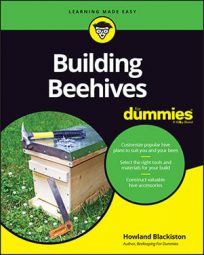Assembling the bits and pieces of a double-screened inner cover for your bee hive is an easy build — just a frame with a couple of screened inserts. Your bees will certainly enjoy the great ventilation!
Assemble the frame.
The short rails align with the notches that were cut from the ends of the long rails. It's kind of like building a picture frame.
Check alignment and fit, and insert one deck screw halfway into each corner of each long rail using your power drill with a #2 Phillips head bit. Place the screws through the long rails and into the short rails. Center each screw top to bottom and place it about 1/2 inch from the outside edge of the assembly. Don't put the screws all the way in quite yet.
First make sure everything is square and fits properly; then, when all looks good, you can screw them in all the way. You have no room for adjustment when all the screws are in! Now add one extra screw in each of the frame's corners. Place them centered top to bottom and spaced about 1 inch from the original four screws (each corner of the long rails will have two screws).
Consider using a weatherproof wood glue in addition to the screws. It helps make the screened inner cover as strong as possible. Apply a thin coat of glue wherever the wooden parts are joined together.
Attach the screening material and place the cover on your hive.
Attach the #8 hardware cloth to the "opening" of the frame (on both sides). The screening settles into the 1/8 inch deep rabbet cut you made. Use 3/8 inch staples spaced approximately 2 inches apart. Staples go around the entire perimeter of the screening. There should be no gaps where the bees could squeeze through.
Don't paint the screened inner cover. Leave it natural and unfinished, as with all the internal parts of any beehive.
Position the screened inner cover on the hive body with the notched entrance facing down and toward the front of the hive (when you want to create an upper entrance for your bees to travel in and out of the hive; see the image on the bottom in the following figure). Or flip it over to close the upper entrance to and from the hive (see the image on the top).
![[Credit: Illustration by Felix Freudzon, Freudzon Design]](https://www.dummies.com/wp-content/uploads/357000.image0.jpg) Credit: Illustration by Felix Freudzon, Freudzon Design
Credit: Illustration by Felix Freudzon, Freudzon Design

